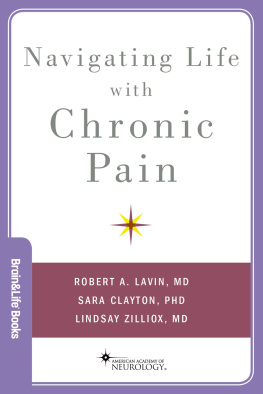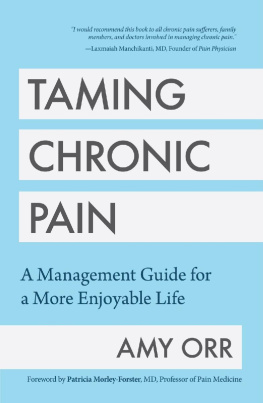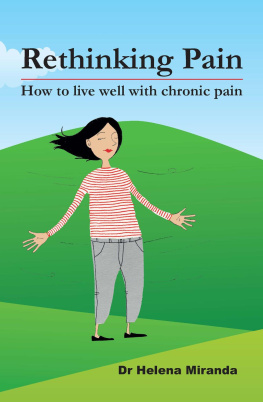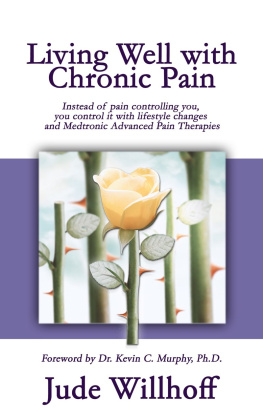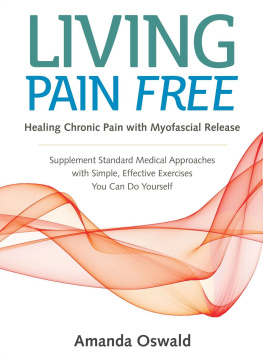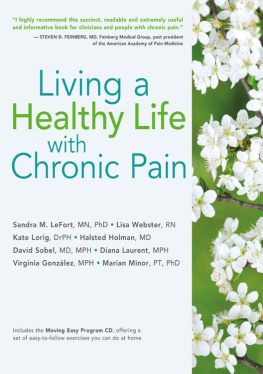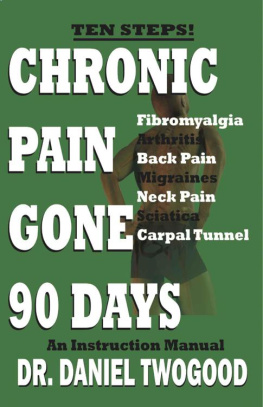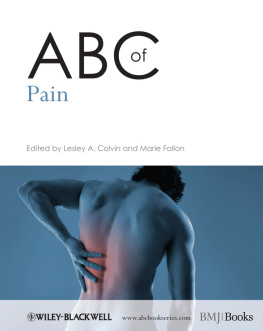Navigating Life with Chronic Pain
Lisa M. Shulman, MD
Editor-in-Chief, Neurology Now Books Series
Fellow of the American Academy of Neurology
Professor of Neurology
The Eugenia Brin Professor in Parkinsons Disease and Movement Disorders
The Rosalyn Newman Distinguished Scholar in Parkinsons Disease
Director, University of Maryland Parkinsons Disease and Movement
Disorders Center
University of Maryland School of Medicine
Baltimore, MD
Other Titles in the Neurology Now Books Series
Navigating Life with Parkinson Disease
Sotirios A. Parashos, MD, PhD; Rose Wichmann, PT; and Todd Melby
Navigating Life with a Brain Tumor
Lynne P. Taylor, MD, FAAN; Alyx B. Porter Umphrey, MD; and Diane Richard
Navigating the Complexities of Stroke
Louis R. Caplan, MD, FAAN
Navigating Life with Multiple Sclerosis
Kathleen Costello, MS, ANP- BC, MSCN; Ben W. Thrower, MD; and Barbara S. Giesser, MD
Navigating Life with Epilepsy
David C. Spencer, MD, FAAN
Navigating Life with Amyotrophic Lateral Sclerosis
Mark B. Bromberg, MD, PhD, FAAN, and Diane Banks Bromberg, JD

Oxford University Press is a department of the University of Oxford. It furthers the Universitys objective of excellence in research, scholarship, and education by publishing worldwide. Oxford is a registered trade mark of Oxford University Press in the UK and certain other countries.
Published in the United States of America by Oxford University Press
198 Madison Avenue, New York, NY 10016, United States of America.
American Academy of Neurology 2020
All rights reserved. No part of this publication may be reproduced, stored in a retrieval system, or transmitted, in any form or by any means, without the prior permission in writing of Oxford University Press, or as expressly permitted by law, by license, or under terms agreed with the appropriate reproduction rights organization. Inquiries concerning reproduction outside the scope of the above should be sent to the Rights Department, Oxford University Press, at the address above.
You must not circulate this work in any other form and you must impose this same condition on any acquirer.
CIP data is on file at the Library of Congress
ISBN 9780190619688
eISBN 9780190619701
This material is not intended to be, and should not be considered, a substitute for medical or other professional advice. Treatment for the conditions described in this material is highly dependent on the individual circumstances. And, while this material is designed to offer accurate information with respect to the subject matter covered and to be current as of the time it was written, research and knowledge about medical and health issues is constantly evolving and dose schedules for medications are being revised continually, with new side effects recognized and accounted for regularly. Readers must therefore always check the product information and clinical procedures with the most up-to-date published product information and data sheets provided by the manufacturers and the most recent codes of conduct and safety regulation. The publisher and the authors make no representations or warranties to readers, express or implied, as to the accuracy or completeness of this material. Without limiting the foregoing, the publisher and the authors make no representations or warranties as to the accuracy or efficacy of the drug dosages mentioned in the material. The authors and the publisher do not accept, and expressly disclaim, any responsibility for any liability, loss or risk that may be claimed or incurred as a consequence of the use and/ or application of any of the contents of this material.
Contents
In this section you will learn about how your body and your mind respond to pain and how it can affect all aspects of your life. You will discover that you are not alone and that pain is frequently misunderstood. In this section you will also learn how you can make the most of your medical visits and work with your doctor to develop a personalized pain plan that is best for you. You will understand how to control your pain by combining a variety of medical and behavioral therapies and physical exercise treatments that are most appropriate for you. You will also learn about the limitations of some pain medications and procedures. While it is unlikely that your pain will completely go away, this section will emphasize self-management skills that allow you to live with your pain by controlling it.
In this chapter you will learn
That you are not alone because pain affects millions of people.
The differences between acute and chronic pain and how the nervous system can amplify pain so that it becomes disabling.
How to take control of your chronic pain and how to reduce pain by learning about tools to self-manage your pain.
Most experts agree that there are two types of pain. Acute pain is pain that has occurred for less than three months, and chronic pain is pain that lasts longer than three months. However, aside from the amount of time that a person has been in pain, there are other important differences between acute and chronic pain. Lets discuss each separately to understand the difference.
Acute Pain
We have all experienced acute pain. It occurs when there is an injuryanything from a scraped knee to a broken bone. The body responds to the injury with painsometimes so much pain that nearby muscles will contract in intense spasms so that it is difficult to even move. This is obviously painful, but acute pain actually serves a purpose because it teaches us to avoid painful situations in the future. It is also protective because the pain prevents us from moving an injured body part so it has a chance to heal. After a period of time, the pain improves as the injury heals. Finally, the term acute refers to the fact that the pain resolves within three months after an injury or surgery. Acute has nothing to do with the severity of the pain because both acute and chronic pain can be severe.
Chronic Pain
In contrast, chronic pain does not go away after three months, and it does not serve any useful purpose. Unlike acute pain, chronic pain continues long after the injury has healed. This book focuses on chronic pain.
Chronic pain can be disabling because it interferes with common activities of daily living (ADLs) that we take for granted. ADLs include tasks like dressing, bathing, walking, getting up from a chair, and even sleeping. Because of the prolonged and exhausting experience of unrelenting pain, many people with chronic pain feel sad and hopeless. Understandably, they may become depressed, anxious, irritable, withdrawn, and even suicidal. These psychological and emotional responses to constant, unrelieved pain are what really makes chronic pain different and more complex than the acute pain that occurs when you scrape your knee.
Joe fell and broke his hip at work. He had surgery to repair the injured hip and was informed that the pain he felt was part of the normal healing process and would go away with time. He used pain medication and attended physical therapy as directed by his doctor. After many months, he was still experiencing the pain, long after his doctor told him that his fracture had healed. The pain interfered with his ability to sleep, work, play with his kids, do chores around the house, and even perform simple activities like pulling up his pants, showering, and getting on and off the toilet. The constant pain had taken over his world. He was no longer the breadwinner for his family, and he was dependent on others for his most basic needs. He felt isolated and stuck in his home. He was no longer able to do things that he enjoyed, like seeing his friends, playing sports, and walking around the neighborhood. It also affected his relationship with his wife and children because he tried to avoid people and frequently got upset over minor things that never used to bother him. Furthermore, sexual relations with his wife were impossible due to the pain. He started to feel depressed, angry, anxious, and lonely.

